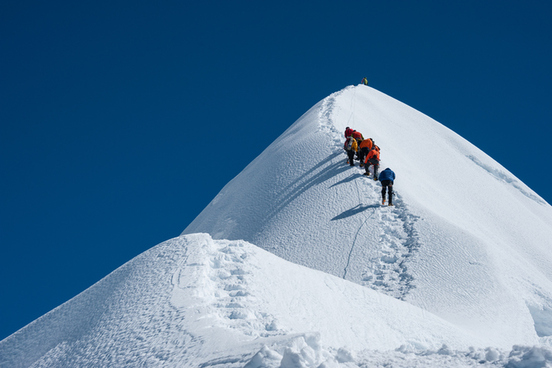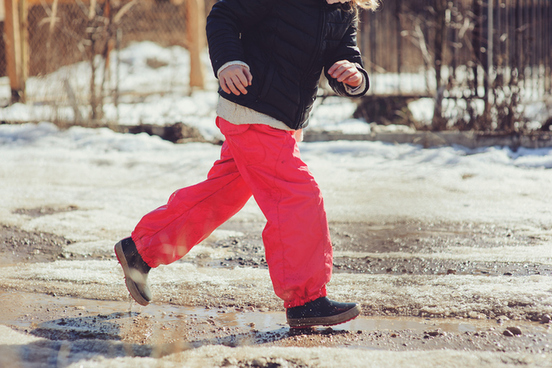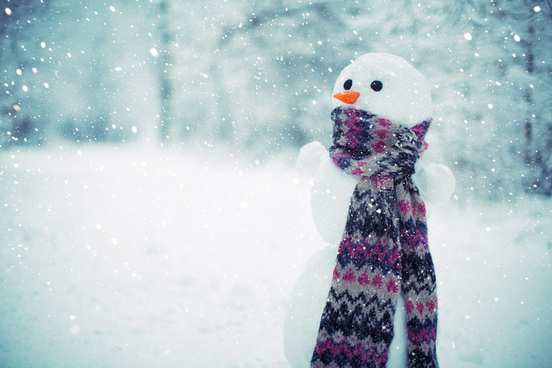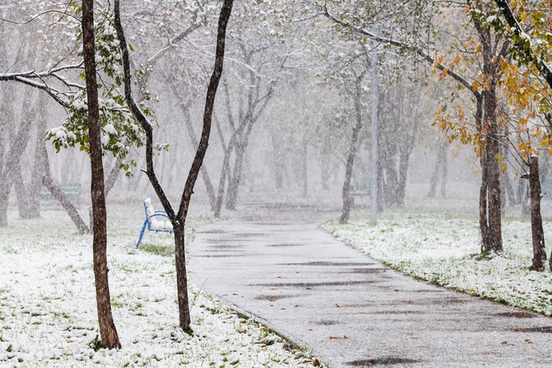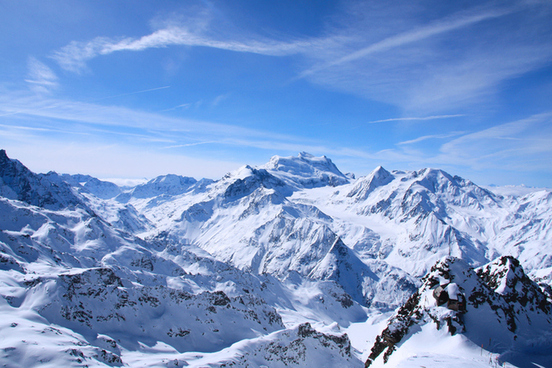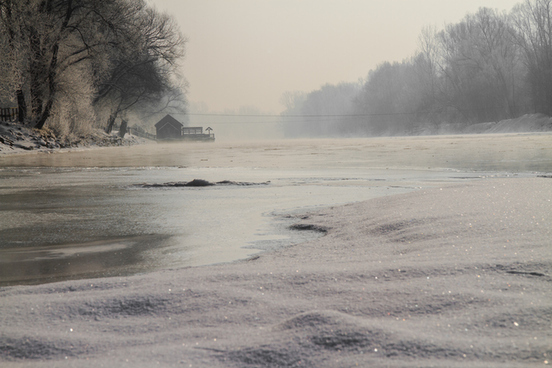Definition: the partially compacted granular snow that forms the surface part of the upper end of a glacier; broadly : a field of granular snow
Névé is indeed snow, although it is of a more particular kind than just “cold white stuff” (and it is also occasionally called firn). The word comes from a word in the Swiss dialect of French, and, prior to that, comes from the Latin word for snow (nix). Our language has used this Latin root to form a large number of words for snow-related things, although most of them are quite obscure. We have niveous (“resembling snow”), subnivean (“situated or occurring under the snow”), and ninguid (defined by Thomas Blount in 1656 as “where much Snow is”).
The distinction between névé and true glacier ice is plainly manifest in the Sierra Nevada glaciers, not only when viewing them from a distance, but also while traversing their surfaces.
—Israel Cook Russell, Existing Glaciers of the United States, 1885
Definition: soft slushy mud or snow
Sposh is thought to be a combination of the words slush and posh, but before you get overly excited about the new factoid with which you plan on boring your in-laws to tears, there are a couple of things you should know. First, posh does not itself come from «port-outward-starboard-home,» or any other acronym. Second, the posh that sposh is based on is a totally different kind of than the one meaning «fashionable»; this one is an archaic word, meaning “a slushy mass (as of mud or broken ice).”
I enjoy not less what may be called the negative side of spring, — those dark dank, dissolving days, yellow sposh and mud and water everywhere, — yet who can stay long indoors?
—John Burroughs, Birds and Poets, 1895
Definition: a long severe snowstorm
Every time there is a blizzard, or even the chance that a blizzard might stop by for a visit, the event will be accompanied by a host of people who will insist on informing you that in order for it to really be a blizzard there must be at least three hours of snow with winds reaching 35 MPH, and visibility of a quarter mile or less.
By Friday night, an “all-out blizzard” is anticipated from central and northeastern South Dakota to central and eastern North Dakota, according to AccuWeather meteorologist Bernie Rayno. Unnecessary travel should be avoided in these areas.
— Doyle Rice, USA Today, 11 Oct. 2019
These conditions are necessary before the National Weather Service in the United States will call something a blizzard; however, for the rest of us, a somewhat less strict definition applies. Blizzard may be applied to such events as “a long severe snowstorm,” “an intensely strong cold wind filled with fine snow,” or figurative uses such as “an overwhelming rush.”
i am dying in lala in a blizzard of sun where
my killers always profit from my death.
—Wanda Coleman, Bathwater Wine, 1998
Definition: a heavy fall of rain or snow
Suppose there’s been a heavy snowfall, but it has not met the strict criteria necessary to be called a blizzard by the National Weather Service, and suppose you are the sort of person who cares about such things…well, what do you call that snowfall (other than inconvenient)? You may call it an onding, a lovely regionalism that has been in use in Scotland and Northern England since the middle of the 18th century.
”Look out, Jock; what night is’t?” “Onding o’ snaw, father,” answered Jock, after having opened the window, and looked out with great composure.
—Walter Scott, The Heart of Mid-Lothian, 1818
Definition: a light fall of snow or rain
Tho there’s not enough snow for a drift,
Just enough has fell that you’re miffed;
Your boss makes you work
(why, the nerve of that jerk)
As he says that it’s naught but a skift.
We had a skift of snow (a sight never before witnessed here at this season of the year), on the night of the 21st. The bees were housed for 3 days.
—G. W. Demaree, (letter) The American Bee Journal, 6 Jun. 1883“We don’t typically plow the entire city just when we get a little skift of snow,” Heintz said. “Two inches or so, we’ll get into those emergency routes, but it needs to get up to about 3.5, 4 inches or a 4-inch accumulation over a number of days before we even consider going into residential.”
— Cheryl McCormack, The Bismarck Tribune, 27 Feb. 2019
Definition: granular snow pellets
Graupel, which is sometimes also referred to as soft hail, comes to English from German, in which language it is the diminutive of the word for “pearl barley” (Graupe). The word appears to have begun being used in the 1870s, when meteorologists of that time decided that there was a need to distinguish between different kinds of hail.
He refers to our comparative ignorance of the origin and peculiarities of the appearance of hail, of the want of long series of observations on the subject, and in those that do exist of the frequent confounding of hail and graupel—the balls of true hail having an icy structure, whereas the balls of graupel are only small pellets of snow.
—Nature, 2 Nov. 1876
Definition: the process whereby snow is changed to névé
Many of the words relating to snow in the English language are short little things, which has doubtless caused some of you to wonder when the fancy words will arrive. Well, firnification is the two dollar word you’ve been looking for. It may be several years before you have an opportunity to use it in the correct context, but just imagine how happy you will be when you find yourself standing on the upper end of a glacier while the snow is actively turning to névé.
In any alpine winter snowscape it seems as though Nature has stood still under its winter mantle, and that all is peace. Yet, in truth, the snow cover is a vast and active laboratory in which the flakes are made to undergo incessant and increasing change, until the time when they disappear in spring and commence their long journey to the sea, or, at high altitudes, become converted into glacier ice. These changes are called ‘firnification.’
—Gerald Seligman, Nature, 26 Jun. 1937
Definition: thin floating ice: snow
There are several meanings of grue, and the obscurity of each makes one wonder how such a pleasant and useful term should have fallen by the linguistic wayside. In addition to having the definition above, grue may function as a verb, meaning “to shiver or shudder, especially with fear or cold,” and with a number of additional noun senses, including “a fit of shivering” and “gruesome quality or effect.”
Thro’ driftin’ snaw, an’ blashie sleet,
Puir bodies wade, an’ grue, an’ grane;
Then comes the white-pow’d warlock frost,
An’ a’ he touches turns to stane.
—Janet Hamilton, Poems of Purpose, 1865
Definition: granular snow formed by alternate thawing and freezing
Corn snow is also referred to as spring snow, and occasionally simply as corn. It is one of the more recent additions to our vocabulary of snow types, beginning to be used (mainly in describing ski conditions) in the early 20th century.
It seems that on the high peaks of the Island of Hawaii, for several months during the year, there is “corn snow.” “Corn snow” is the finest there is for skiers. It is dry and crunchy. At least, so says Mr. Larson.
—Ed Ainsworth, The Los Angeles Times, 6 Sept. 1937
Definition: frozen or partly frozen rain
Sleet is basically the ambivert of weather systems. Go on … you know you want to go look up what ambivert is.
But now, dear love, is the summer’s reign,
And the thistles wound our feet;
We seek escape from their thorns in vain,
And climb the hillside with toil and pain,
Yet knowing and saying again and again
That thistles are kinder than sleet, beloved,
Thistles are kinder than sleet!
—Elizabeth Akers Allen, Poems, 1868
What are other names for snow?
snowpowder snow.sleet.slush.snow blanket.snow crystal.snowbank.snowdrift.snowfall.
What is the Latin word for snowflake?
EnglishLatin (translated indirectly)Esperantosnow common nounnix common nounneĝo common noun
What is the Native American word for snow?
Native American Baby NamesNAMEGMEANINGYaholoMCrierYanisinMAshamedYasMSnowYatokyaFSun11
What is the Native American word for white?
Wašíču is the Lakota and Dakota word for people of European descent. It expresses the indigenous population’s perception of the non-natives’ relationship with the land and the indigenous population. Typically it refers to white people but does not specifically mention skin color or race.
How do you say winter in Cherokee?
0:17Suggested clip · 15 secondsCHEROKEE WORD OF THE WEEK: WINTER – YouTubeYouTubeStart of suggested clipEnd of suggested clip
What is the Native American word for spirit?
CATORI: Hopi name meaning spirit.”
What God do Native American believe in?
The Great Spirit is a conception of universal spiritual force, Supreme Being or God, and is known as Wakan Tanka among the Sioux, Gitche Manitou in Algonquian, and in many Native American (excluding Alaskan Natives) and Aboriginal Canadian (specifically First Nations people).
What are the beliefs of Native American?
Early European explorers describe individual Native American tribes and even small bands as each having their own religious practices. Theology may be monotheistic, polytheistic, henotheistic, animistic, shamanistic, pantheistic or any combination thereof, among others.
What does an arrow mean in Native American?
Arrow. The arrow is a literal representation of the bow and arrow weapon, used to acquire food for one’s tribe. In a more metaphorical sense, the arrow represents protection and defense. A broken arrow symbolizes peace among different tribes.
How important was religion in Native American daily life?
The religion and spiritual beliefs of Native Americans played an important role in their everyday life. Each tribe and peoples had their own unique beliefs, legends, and rituals, but they all believed that the world was filled with spirits.
How old is the Native American religion?
The Native American church emerged in the mid-19th century when an ancient ritual of central Mexico moved into the United States and blended with Christian influences.
Do Indians believe in God?
Hindus worship many gods and goddesses in addition to Brahman, who is believed to be the supreme God force present in all things. Some of the most prominent deities include: Brahma: the god responsible for the creation of the world and all living things. Vishnu: the god that preserves and protects the universe.
What was the very first church ever?
According to the Catholic Encyclopedia the Cenacle (the site of the Last Supper) in Jerusalem was the “first Christian church.” Archaeology magazine suggests that the Dura-Europos church in Syria is the oldest surviving church building in the world, while Jordan’s Aqaba Church is considered to be the world’s first …
What are different words for snow?
other words for snow
- blizzard.
- snowfall.
- snow flurry.
What does the French word Neve mean?
French dialect (Swiss), from Vulgar Latin *nivatum, from Latin niv-, nix snow — more at snow.
What is slang for snow?
SNOW means “Cocaine” So now you know – SNOW means “Cocaine” – don’t thank us.
What is very light snow called?
snow flurries
What is light and fluffy snow called?
Graupel is sometimes mistaken for hail, but tends to have a texture that is softer and more crumbly. Graupel is sometimes also called snow pellets.
What are the 4 types of snow?
There are four types of snow crystals. They are called:
- Snowflakes – These are single ice crystals or clusters of ice crystals that fall from a cloud.
- Hoarfrost – When ice crystals fall on a surface (like tree branches, leaves, wires, etc.)
- Graupel – These are cute, opaque, capsule-shaped ice crystals.
What makes snow light and fluffy?
The light fluffy snow forms when all layers of the atmosphere are below freezing. because the air is cold, all the way down to the surface, snowflakes don’t melt. That allows the individual flakes to stay light and fluffy.
Is snow hard or soft?
This is the fresh snow. But after the snow has been on the ground for a few days, that air gets squeezed out, and the old snow doesn’t even look like a snowflake anymore. Notice there is almost no air inside of the ice and it looks solid. So, this is why ice feels hard.
What is slushy snow?
Snow that partially melts upon reaching the ground, to the point that it accumulates in puddles of partially frozen water, is slush, whereas sleet is snow falling mixed with rain, that is, rain containing snow. Slush is slurry, mixture of liquid and solid forms of water.
Can you eat snow?
It is generally safe to eat snow or use it for drinking or for making ice cream, but there are some important exceptions. If the snow is lily-white, you can safely ingest it. But if the snow is colored in any way, you’ll need to stop, examine its color, and understand what it means.
What is dry snow?
Dry snow is more common as it occurs when the surface air temperature is below freezing. Unlike wet snow, dry snow is powdery and cannot easily be formed into snowballs or snowmen. In addition, colder air temperatures correlate to lighter and fluffier snow that contains less water per inch.
What is wet vs dry snow?
Wet snow generally has a snow depth to melted liquid depth ratio of less than 10. Dry snow generally has a snow depth to melted liquid depth ratio of greater than 20. Dry snow is powdery, easily blown around by the wind and is not sticky.
How do you get sticky snow?
But if it doesn’t refreeze over night on normal non glacial snow then as the sun warms the snow it will rapidly transform into wetter snow with a higher water content. This water creates the stickiness and after a certain it can have enough adhesion to literally stop you in your tracks.
Can ice be wet?
Ice on its own is not wet, because it’s a solid. However if the ice is in an environment that’s warmer than 0°C, the surface of the ice will be wet, because it is melting. If it’s cold enough to not melt on contact, then no, ice is not wet. It’s a solid, not liquid.
Is ice still H2O?
Water is H2O. Ice is H2O. c. Water vapor is H2O Adam Sennet has no problem with this.
Is ice dry water?
And it IS indeed dry. Regular ice is frozen water. When it gets warm, it melts and turns from solid ice back into liquid water.
Is Wet ice slippery?
Everybody knows ice is slippery. Even at 200 degrees or more below zero, seemingly solid ice is — in a sense — all wet, the researchers say. Unlike other solids that are, in fact, solid all the way to their surfaces, an extremely thin, quasi-fluid layer coats the surface of frozen water, they conclude.
Do scientists know why ice is slippery?
Ice on its own isn’t actually slippery; it’s friction that causes it to become slick, according to Phys.org. The friction on the ice causes a very thin layer of water to develop on top. That little bit of water laid over the icy surface is what causes the slipperiness.
Why ice is slippery than water?
The “slippery” nature of ice is generally attributed to the formation of a thin layer of liquid water generated by friction, which for instance allows an ice skater to “surf” on top of this liquid film. The mystery of sliding on ice can therefore be found in the “viscous” nature of this film of water.
At what temperature does ice stop being slippery?
A collection of researchers discovered that the ideal slippage point occurs at a temperature of -7 degrees Celsius, or about 20 degrees Fahrenheit. Temperatures colder than this point reduce the energy in the ice network and thus make it more difficult to break their weak bonds and roll across the surface.
Can ice not be slippery?
Try telling someone who has just fallen on a patch of ice that ice is not slippery and they’ll think you’re crazy. But, in fact, ice itself isn’t slippery because it is a solid. One quality of solids is that when two solids are together there is friction between them that will keep them from slipping.
At what temp does black ice form?
32 degrees
How can you tell if a road is icy?
When the temperature is between 30 to 34 degrees, rain will turn to sleet or ice. This can cause roads to get icy quickly. You can tell when ice is forming on the roads. The ice gives the roads a shiny glossy look.
What is the best vehicle for snow and ice?
- 2021 Dodge Challenger.
- 2020 Mazda3.
- 2020 Audi A4 Allroad.
- 2021 Honda CR-V.
- 2020 Ford Ranger.
- 2020 BMW 2 Series. $35,300 | U.S. News Overall Score: 8.7/10.
- 2021 Jeep Grand Cherokee. $32,350 | U.S. News Overall Score: 7.6/10.
- 10 Best Cars for Winter Driving in 2020. 2021 Subaru Outback – $26,795 | U.S. News Overall Score: 8.0/10.
Do you turn into a skid or away?
For a rear-wheel or all-wheel skid in which your car starts to spin out of line, “Steer into the skid,” which means steer to the same side the back end of the car is sliding towards. During a front-wheel skid, straighten the steering wheel.
What time of day is black ice most common?
early morning hours
What are different words for snow?
by
Alex Heath
·
2019-03-03
What are different words for snow?
synonyms for snow
- blizzard.
- snowfall.
- snow flurry.
What is the Native American word for snow?
u-na-tsi
How do you say snow in Yupik?
Inuit/Yupik Words for Snow: 40-50 Some examples: Qanik: snow falling. Aputi: snow on the ground. Aniu: Snow used to make water.
Are there 50 words for snow?
Some have even gone as far as to name it the Great Eskimo Vocabulary Hoax. The latest evidence, however, suggests that Boas was right all along. This debate has rumbled on partly because of a grammatical peculiarity of the Eskimo family of languages.
How do you say love in Inuit?
We reserved Nagligivaget, the Inuit way of saying “I love you,” for last to prove that, even at the ends of the Earth, even in the coldest places, the warmth of love and the heat of passion rings true. Even when things are so cold that you cover your entire body several times over.
What can I say instead of I Love You?
Try these simple but thoughtful ways to tell someone what they mean to you.
- I’m crazy about you.
- You’re my dream come true.
- You take my breath away.
- Since you’ve been around I smile a lot more than I used to.
- There is no one I’d rather steal blankets from.
- You’re my partner in crime.
- You look great today and every day.
How do you say hi in Inuit?
Atelihai, pronounced ahh-tee-lee-hi, is the Inuktitut word for “hello” or “welcome.”
How do you say beautiful in Inuit?
In a flood of responses to a post on Nunatsiaq News’ Facebook page, most Inuit say the word beautiful translates as “piujuq” or “pinniqtuq” in the Nunavut or Nunavik dialects of Inuktitut.
How do you say seal in Inuit?
When the Inuit refer in English to “seal”, they almost always mean nattiq, the ringed seal. There is no Inuktitut word for “seal” in general.
What does Miska mean in Inuit?
Miska – little bear. Nanook – cute or kind.
How do you say good night in Inuit?
Ikajunga! (Ee-ka-yu-nga!) Good morning. Good night.
How do you say sorry in Inuit?
There is a word for “sorry” in Inuktitut, the way we say it in Nunavik: ᐃᓛᓂᐅᖕᖏᑐᖅ (ilaaniungituq). But we rarely use it. We say sorry, or ask for forgiveness, not so much in words, but through our silent gestures and our actions reflecting kindness.
How do you say Mom in Inuit?
ll is a rolled “l” sound. The diagram below shows the place of articulation (the origin of the sound in the mouth) for each Inuktitut sound….Inuit Nipingit—Inuit Sounds.
| Inuktitut Term | Pronunciation | Meaning |
|---|---|---|
| Anaana | a-NAA-na | Mother |
| Anaanatsiaq | a-NAA-nat-si-aq | Grandmother |
| angaju | a-ŊA-yu | older brother |
| angakkuq | a-ŋak-KOOQ | shaman |
How do you say igloo in Inuit?
The igloo, also called “iglu” in Inuit language, is typically built when snow can be easily compacted, therefore making a cozy shelter.
What does igloo mean in Inuit?
Some igloos are built for temporary shelter, while others are permanent, warm housing in very cold climates. The noun igloo comes from an Inuit word, iglu, which means simply “house,” no matter what it’s constructed from.
Is Igloo a problematic word?
“Misleading title. Igloos are made out of ice.” Nope, though that’s a common misconception. Only a few groups of the Inuit/Inupiat/Yup’ik people actually lived in iglus made of snow (not ice), though many groups used them for temporary shelter while on (e.g.) hunting trips.
Can I say igloo?
Here are 4 tips that should help you perfect your pronunciation of ‘igloo’: Break ‘igloo’ down into sounds: [IG] + [LOO] – say it out loud and exaggerate the sounds until you can consistently produce them.
How Do You Talk to an iguana?
Here are 4 tips that should help you perfect your pronunciation of ‘iguana’:
- Break ‘iguana’ down into sounds: [I] + [GWAA] + [NUH] – say it out loud and exaggerate the sounds until you can consistently produce them.
- Record yourself saying ‘iguana’ in full sentences, then watch yourself and listen.
Do we say an igloo or a igloo?
noun, plural ig·loos. an Inuit house, being a dome-shaped hut usually built of blocks of hard snow. any dome-shaped construction thought to resemble an igloo: immense silos topped with steel igloos. …
Can you light a fire in an igloo?
But while a central fire will always deliver some heat to the ice of the igloo, the ice of the igloo will also tend to lose heat to colder air outside. As long as the ice loses heat at least as fast as the fire delivers heat to it, the ice won’t become any warmer and it won’t melt.
Can you suffocate in an igloo?
A regular igloo contains 10,000 litres of air inside which is enough for one person to stay inside for 23 hours, considering an average intake of 7.18 litres/minute during sleep.
How tall was the world’s largest igloo?
10.5 m tall
Asked by: Verda Gulgowski
Score: 4.5/5
(38 votes)
noun A melting of snow; a thaw. noun In forestry, the breaking of trees by snow.
What is a snow break?
1 : a melting of snow : thaw. 2a : a breaking of trees by snow. b : an area over which there has been such breakage. 3 : a protective barrier (as of planted trees along a highway or railroad) against drifting snow.
What do you call a small snow?
Flurry: A brief snowfall that produces little to no accumulation. Graupel: Also called snow pellets, graupel refers to round, opaque snowflakes that almost look like polystyrene pellets. They form when regular snowflakes fall through ice-cold liquid clouds. … Graupel is similar to hail, but is smaller and less dense.
Do you hyphenate snow White?
You are forming a compound modifier from a noun phrase (Snow White) and the past participle of a verb (themed). Compound modifiers are typically hyphenated when they precede the noun they modify.
How do you say snow in Swiss?
Névé is indeed snow, although it is of a more particular kind than just “cold white stuff” (and it is also occasionally called firn). The word comes from a word in the Swiss dialect of French, and, prior to that, comes from the Latin word for snow (nix).
23 related questions found
What is the Russian word for snow?
The general word for snow in Russian is snjeg (снег), but in the list below you will find some other common words from the Russian language used to describe this weather phenomenon from different sides.
What are the Eskimo words for snow?
Here are just some Eskimo-Aleut snow lexemes:
- qanuk: ‘snowflake’
- kaneq: ‘frost’
- kanevvluk: ‘fine snow’
- qanikcaq: ‘snow on ground’
- muruaneq: ‘soft deep snow’
- nutaryuk: ‘fresh snow’
- pirta: ‘blizzard’
- qengaruk: ‘snow bank’
Is blood red hyphenated?
3 Answers. You would not use hyphens when the phrase is used as a noun: Blood red had always been his favorite color. The flag had white lion on a field of forest green.
Is 12 month period hyphenated?
Hyphenate Numerals with Units of Time before Nouns
Like spelled-out numbers, hyphenate numerals with units of time that appear directly before the nouns they are describing. A 45-day drought damaged the soybean crops. The student bought a new 12-month desk calendar.
Is a word Joined by hyphens?
Compound words can be written in three ways: as open compounds (spelled as two words, e.g., ice cream), closed compounds (joined to form a single word, e.g., doorknob), or hyphenated compounds (two words joined by a hyphen, e.g., long-term). Sometimes, more than two words can form a compound (e.g., mother-in-law).
What is slang for snow?
Snow is a slang term for Coke or Cocaine.
What is a fancy name for snow?
The frozen, crystalline state of water that falls as precipitation. blizzard. snowdrift. snowfall. snowflakes.
What is Black snow called?
Black ice, sometimes called clear ice, is a thin coating of glaze ice on a surface, especially on roads. The ice itself is not black, but visually transparent, allowing the often black road below to be seen through it.
What do snow breaks do?
Snow guards evenly distribute the weight of snow and ice and help protect against damage. Snow guards are most effective when they are installed evenly over the surface of the roof material. The protuberances grab the heavy sheet of snow, stabilizing the sheet, keeping it in place.
Are snow guards required by code?
Snowpack, or the buildup of snow and ice, on any roof can produce significant sliding forces. … In most alpine regions of Europe and Scandinavia, the use of snow-guard systems is mandated by building authorities, however such policy in North America is quite rare and only required by local code authorities if at all.
Is 30 minute hyphenated?
Determine whether you’re using the number of minutes as an adjective to describe a noun. If so, hyphenate. … Refrain from hyphenating the number of minutes if they’re not modifying the noun. For example, you wouldn’t hyphenate «Lisa’s jog lasted 30 minutes» because in this case, «30 minutes» isn’t an adjective.
Is it 30 days or 30 day?
1 Answer. When you are using it as a noun phrase, you say «30 days». When you are using it as an adjective, you say «30-day». For example, «The project will last for 30 days», versus «This is a 30-day project».
Should 24 hour be hyphenated?
Compound Numbers that are below one hundred and made up of two words require hyphenation. Compound adjectives used before a noun are hyphenated as well, requiring «24» and «hour» to be hyphenated in «24-hour shift». So only example 3, «I am doing a twenty-four-hour shift tonight» is correctly hyphenated.
Do you hyphenate color?
As with most other phrasal adjectives, pairs of words that together describe the color of an object should be hyphenated: A suit that is dark blue (referring to degree of saturation) is a dark-blue suit, and a suit that is blue gray (identifying a combination of colors) is a blue-gray suit.
Is cherry red hyphenated?
Is the color combination used as a compound adjective after a noun, such as in the following sentences? The chair is cherry red. YES: In general, leave as two words unless hyphenation is deemed necessary for clarity.
Is Ruby red hyphenated?
and still make sense. In that case, no hyphen is needed. in which ruby modifies red, but can also be said to modify gown.
What words describe snow?
Explanation:
- slushy.
- crunchy.
- powder.
- crystalline.
- picturesque.
- heavy.
- obscuring.
- whiteout.
Which language has 400 words for snow?
Scotland has more than 400 words and expressions for snow, according to a project to compile a Scots thesaurus. Academics have officially logged 421 terms — including «snaw» (snow), «sneesl» (to begin to rain or snow) and «skelf» (a large snowflake).
What is the Native American word for snow?
The Cherokee word for snow is u-na-tsi (ᎤᎾᏥ).
In other languages White
- American English: white /ˈwaɪt/
- Arabic: أَبْيَض
- Brazilian Portuguese: branco.
- Chinese: 白的
- Croatian: bijeli.
- Czech: bílý
- Danish: hvid.
- Dutch: wit.
In other languages snow
- American English: snow /ˈsnoʊ/
- Arabic: ثَلْج
- Brazilian Portuguese: neve.
- Chinese: 雪
- Croatian: snijeg.
- Czech: sníh.
- Danish: sne.
- Dutch: sneeuw.
What is white Japanese?
White is called shiro (白) in Japanese.
How do you say Snow White in other languages?
In other languages Snow White
- American English: snow-white /ˌsnoʊˈwaɪt/
- Brazilian Portuguese: branco como neve.
- Chinese: 雪白的
- European Spanish: blanco como la nieve.
- French: blanc comme neige.
- German: schneeweiß
- Italian: candido.
- Japanese: 純白の
How do you say Bright in other languages?
In other languages bright
- American English: bright /ˈbraɪt/
- Arabic: ساطِع
- Brazilian Portuguese: claro.
- Chinese: 明亮的
- Croatian: svijetao.
- Czech: jasný
- Danish: klar kraftigt lysende.
- Dutch: fel.
What is the Eskimo word for snow?
Inuit/Yupik Words for Snow: 40-50
Aputi: snow on the ground. Aniu: Snow used to make water. Maujaq (Nunavik): The snow in which one sinks.
What is the Native American word for snow?
kanevvluk: ‘fine snow’ qanikcaq: ‘snow on ground’ muruaneq: ‘soft deep snow’ nutaryuk: ‘fresh snow’
What is the kanji for white?
白
The “White” Radical: 白
How do you say white in Japanese hiragana?
Japanese words for colors are predominantly no-adjectives, in contrast other basic adjectives, which are primarily i-adjectives and na-adjectives.
Primary Colors.
| Hiragana | Romaji | English |
|---|---|---|
| しろ | shiro | white |
| くろ | kuro | black |
What color is Kuro?
Black
Main colors in Japanese with Audio
| English | Japenglish | Japanese (nouns) |
|---|---|---|
| Brown | ブラウン Buraun | 茶色(ちゃいろ) Chairo |
| Purple / Violet | パープル Paaparu | 紫(むらさき) Murasaki |
| Black | ブラック Burakku | 黒(くろ) Kuro |
| White | ワイト Waito | 白(しろ) Shiro |
What is snowflake in other language?
Danish: snefnug. Dutch: sneeuwvlokje. European Spanish: copo de nieve. Finnish: lumihiutale. French: flocon de neige.
How do you say sparkle in different languages?
In other languages sparkle
- Brazilian Portuguese: cintilar.
- Chinese: 闪闪发光
- European Spanish: relucir.
- French: scintiller.
- German: funkeln.
- Italian: sfavillare.
- Japanese: 輝く
- Korean: 반짝이다
How do you say beautiful in other languages?
“Beautiful” isn’t just for lovers either, saying it to your children, mom, or best friend totally works, too.
- Afrikaans: “pragtige”
- Albanian: “bukur”
- Arabic: “hellwa”
- Belarusian: “pryhožaja”
- Bosnian: “lijepa”
- Bulgarian: “krasiv”
- Catalan: “bonica”
- Chinese: “Meilì”
How do you say unique in other languages?
In other languages unique
- Arabic: فَرِيد
- Brazilian Portuguese: único.
- Chinese: 独特的
- Croatian: jedinstven.
- Czech: jedinečný
- Danish: unik.
- Dutch: uniek.
- European Spanish: único especial.
What is the Scottish word for snow?
snaw
Academics have officially logged 421 terms – including “snaw” (snow), “sneesl” (to begin to rain or snow) and “skelf” (a large snowflake). The study by the University of Glasgow is part of a project to compile the first Historical Thesaurus of Scots, which is being published online.
What are the 421 words for snow in Scotland?
Scots ‘have 421 words’ for snow
- feefle – to swirl.
- flindrikin – a slight snow shower.
- snaw-pouther – fine driving snow.
- spitters – small drops or flakes of wind-driven rain or snow.
- unbrak – the beginning of a thaw.
What is the Eskimo word for love?
Up in Alaska, Aleut is one of the 11 Eskimo-Aleut languages that are native to this part of the world (one of which is now extinct). If you’re looking to say “I love you” in Aleut, you’ll need to wrap your tongue around “Txin yaxtakuq.”
What is the Cherokee word for white?
Unega
Study the words and phrases below.
| ENGLISH | TSALAGI (CHEROKEE) | Phonetic Pronunciation |
|---|---|---|
| White | Unega | Oo-nay-gah |
| Black | Agvnige | Ah-guh-nee-gay |
| Blue | Sakonige | Sah-koh-nee-gay |
| Yellow | Dalonige | Dah-lo-nee-gay |
What is the Native American word for white?
Wašíču is the Lakota and Dakota word for people of Western European descent. It expresses the indigenous population’s perception of the non-natives’ relationship with the land and the indigenous population. Typically it refers to white people but does not specifically mention skin color or race.
Does Shira mean white?
Characters Named Shira
白姫, pronounced she-ra-he-meh in Japanese, means translated ‘White Princess’. The Kanji characters for white and princess suggest ‘purity’ and ‘goodness’ – both important ideals.
What is red kanji?
Red is generally called “aka (赤)” in Japanese.

